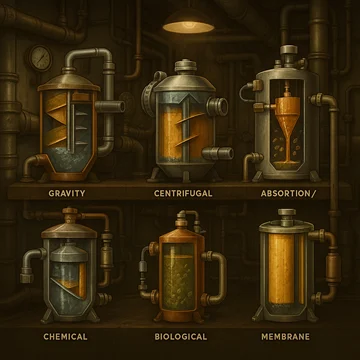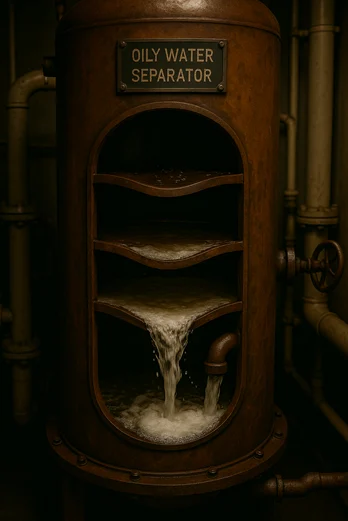Let’s be honest nobody really cares about oily water separators until something goes wrong. But if you’re working on a ship, whether you’re in the engine room or even just passing by the bilge area, you should have a basic idea of how these machines work.
Oily Water Separators (OWS) do one job: get the oil out of the bilge water so you don’t get slapped with fines or pollute the ocean. Simple in theory, but the way they do it varies depending on what system the ship has. Some are easy to use. Others? Not so much.
Here’s a breakdown of the main types of oily water separators you’ll run into on ships.
- Gravity Type
This one just lets oil do its thing
This is the most basic setup. Oil is lighter than water, right? So you let the oily water sit still in a chamber. Oil slowly rises to the top, water stays at the bottom. That’s it.Some ships have baffles or plates inside the separator to speed things up they help tiny oil droplets stick together and float. A few systems even have a heater to help separation.
Why it works:
- Simple as hell
- No electricity needed
- Doesn’t break down often
But
- It struggles with emulsions (when oil and water are mixed too tightly)
- Sometimes can’t hit the required under-15 ppm without extra filters
Where you’ll find it:
Old ships, small boats, budget-tight operations anywhere they don’t want overcomplicated systems.
- Centrifugal Type
This one spins like mad
Ever used a fuel purifier? It’s the same concept. It spins oily water at high speed. The heavier stuff (water) gets flung outward, the lighter stuff (oil) stays closer to the center, and both are taken out separately.
Why people like it:
- Super quick
- Can handle nasty, mixed-up bilge
- Doesn’t take up much space
The downside:
- Needs power to run
- Maintenance is a bit more work
- Expensive, not really for older ships
You’ll see this on:
Big tankers, new builds, or vessels sailing in rough seas where basic systems won’t cut it
- Absorption / Adsorption Type
This one trap oil like a sponge
The water passes through a filter material usually something like organoclay or carbon and the oil gets stuck inside. Kind of like a sponge soaking up a spill on the floor.
What it’s good for:
- Polishing up the last traces of oil
- Works well after gravity systems
- Helps meet stricter discharge rules
What’s annoying:
- Filters clog eventually and need to be replaced
- You’ve got to deal with the used filters (you can’t just bin them casually)
Where it’s used:
In setups where gravity alone doesn’t cut it or in stricter areas where you need crystal-clear discharge water.
- Chemical Type
Sometimes you’ve got to throw in some juice
This one adds chemicals to the bilge water to “break” the emulsion. The oil particles group together into big globs (called flocs), and they separate easily after that.
Why it’s used:
- When you’re dealing with stubborn emulsified bilge water
- Works as a second stage in a bigger system
What’s the catch?
- You’ll get sludge you’ll need to clean out
- You’ll also need to keep chemical stock and storage space
- Crew sometimes hate dealing with the mess
Ships using systems like JOWA 3SEP or in tougher discharge zones
- Biological Type
Yes, it uses bacteria. Seriously.
This one’s kind of wild. It uses microbes that eat the oil. You send oily bilge water into a bioreactor, and these little bacteria chow down on the hydrocarbons and convert them into CO₂ and clean water.
Why it’s clever:
- Good for the environment
- Can handle more than just oil even detergents and chemicals
But reality check:
- It’s slow
- Needs perfect conditions (temperature, pH, etc.)
- Bacteria can die easily if the balance goes off
- Expensive and fussy
Where you’ll actually see it:
Not on most merchant vessels. Think oil rigs, offshore platforms, and ships with money to spend.
- Membrane Type
Filters so fine, oil has no chance
These use super-fine filters so tight that oil can’t even pass through. The water goes in, and only clean water comes out. The oil stays trapped on the other side.
Why it’s solid:
- You can meet discharge limits even stricter than 15 ppm
- Some systems go below 5 ppm
But don’t forget:
- Filters clog easily
- High maintenance
- Expensive as hell
Seen on:
Cruise ships, naval vessels, and new eco-rated merchant ships

Summary:
Most of us onboard just want the OWS to work when we need it. The key is knowing what kind you have, how to maintain it, and how to avoid setting off the oil content monitor. Each type has its pros and cons, but they all aim to keep your discharge clean and you out of trouble.
Nothing worse than getting detained or fined over something that could’ve been fixed during rounds. So yeah, respect your OWS, check it regularly, and don’t wait until it alarms at 2 AM to learn how it works


